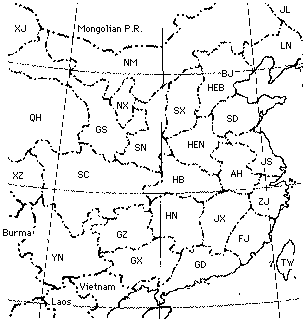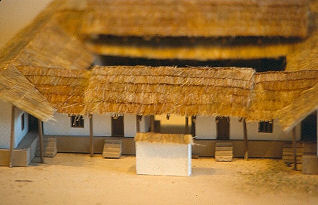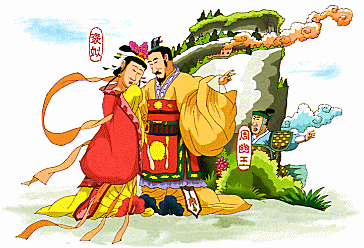
|
Go to China Resources page
Go to Jordan's main page. Go to previous file, next file. |
Content Revised 2009-04-14 File last modified: |

The long centuries that make up the Zhōu Dynasty (from about 1100 to 222 BC) are divided by historians into two parts. The first is called the Western Zhōu 西周. It was established with the fall of the Shāng (probably about 1046, although the traditional date is earlier) and the establishment of a center of administration at Gǎojīng 镐京, not far from the plain where the Shāng forces surrendered.
Possibly one of the many planners of the fall of the Shāng was a figure known to history as King Wén 文, who was the last king of the Zhōu state before it conquered the Shāng. King Wén reigned over Zhōu (under the oppressive overlordship of Shāng) for nearly half a century, and was considered by later writers to have been a paragon of virtue and a great moral exemplar. In this, he was a great contrast to the hated King Zhòu of Shāng, his overlord, who eventually imprisoned him.
King Wén is sometimes credited as founding the Zhōu Dynasty from his prison cell (although that would have been a bit un-exemplary for the better sort of feudal subordinate). But in fact it was his son, King Wǔ 武 (reign 04b-1), who finally did the deed some years after King Wén's death. "Wén" means "civil" while Wǔ means "martial," and the titles do describe the two men, for Wǔ appears to have been far more a man of action and readier to bash heads than was his saintly father.
Much as they had hated King Zhòu, the Shāng people had little love for their new Zhōu rulers, whom they may well have regarded as boorish, if vigorous, and not particularly desirable overlords. To maintain the peace, King Wǔ is said to have assigned the dead tyrant's son, confusingly named Wǔ Gēng 武庚, as the puppet ruler of the old Shāng capital settlement. There was no special reason to believe that the Shāng people had any more love for Wǔ Gēng than they had for their Zhōu conquerors. After all, he was the son of the hated King Zhòu, and it is hard to think that he would have been thought very admirable. King Wǔ might have had any of several possibilities in mind:
Whether people liked Wǔ Gēng or not, at least he was one of their own, and King Wǔ probably reasoned that his appointment would calm things down.
However, unsure about whether he could trust Wǔ Gēng —he probably couldn't— King Wǔ also assigned three of his own half-brothers to go and serve as courtiers to Wǔ Gēng so they could keep an eye on him. Their names were Guǎn shū 管叔, Cài shū 蔡叔 and Huò shū 霍叔. (It is unclear whether the element shū was part of their names or a kind of title. Today the word refers to a father's younger brother.) They were collectively referred to as the "three supervisors" 三监.
Allowing Wǔ Gēng to live was probably a military mistake. The Chinese expression is "freeing a tiger to return to its lair" 放虎归山 to attack again in the future. And that is what he did.
Wǔ Gēng bided his time, and then, when King Wǔ's young son, King Chéng 成王 ascended the throne, the new king was met by a rebellion by Wǔ Gēng, assisted by none other than King Wǔ's half-brothers Guǎn shū and Cài shū, and even including those famous Eastern Barbarians, the Yí, who had been King Wǔ's allies in the uprising against the Shāng.

Fortunately, in King Chéng's court there was an able general and statesman, a certain Duke Dàn 旦, who not only put down the rebellion, but marched on to extend Zhōu rule over the Yí territory, and expanded southward into the Huái River 淮河 valley, which runs eastward across the Central Plain about mid-way between the Yellow River and the Yangzi River. He then built a permanent settlement on the site that is today the city of Luòyáng 洛阳 in northern Hénán (HEN) Province, a place that was destined to become a capital of many later governments.
Duke Dàn's efforts on behalf of the young monarch stood in strong contrast to the betrayal of Guǎn shū and Cài shū, and he lives on in history as the model of a loyal subject, a frequent moral examplar held up in the books of the Confucian canon of later Zhōu times, where he is simply referred to as the "Duke of Zhōu" 周公. Had he seized power, he would have been just another minor footnote in the bloody history of military coups. As an upright, ingenious, and loyal supporter of his young king, his memory has lived for over two thousand years.
All of this comes to us from much later accounts. The Shāng people, after all, have left us virtually no texts, and our Zhōu writings come from late in that dynasty —in fact they are much later copies of texts putatively composed in the late Zhōu. So most of what we know comes from writers who lived several hundred years after the events they describe.
Modern reconstructions of the political system of the Zhōu state see it as (probably) a continuation of the Shāng division between directly ruled and distantly influenced lands, with the power of the central government difficult to wield effectively as distance from the center was greater. Still, it would have incorporated additional features as well.
One reconstruction postulates that, although the central king or wáng 王 bore the unique title "Son of Heaven" 天子 in his quality as monarch, he was also regarded simultaneously as the zōngzhǔ 宗主 or leader (zhǔ 主) of the ruling clan or zōng 宗. His sons (by many wives) acted as his agents across the land, administering great fiefs in theory as sub-leaders on behalf of the clan, with the title "little clans" 小宗. These great fiefs they divided among their own sons, who held lesser titles. The titles "ministers" 卿大夫 and "shì" 士 occur at these lower levels. (By later times the word shì came to refer to members of a class of scholar-bureaucrats, but it seems not to have done so in early Zhōu times.)
However not all land was divided out among the king's sons, it appears. The immediate area of the "capital" settlement was referred to as the King's Land or wáng jī 王畿, where the word jī refers to land on the very outskirts of a large settlement. This land was administered for the monarch by a royal agent, providing direct royal income. Some other nearby lands were also allocated to important figures in the administration and they ruled them directly.
Later dynasties freely use such terms as sītú 司徒, "ministers," and dàchén, 大臣 "great lords," in referring to them, in contrast to the clan-linked titles mentioned above. This suggests that a model built exclusively on rule by a single clan may not be accurate. That is also suggested by the fact that lands beyond the wáng jī that were not fiefs of royal sons and their offspring were, like all lands, still the property of the Son of Heaven, but were allocated to lesser lords (with the title hóu 侯), who held them on behalf of the king, not the clan, in a kind of feudal system.
Thus, although the Zhōu "feudal" system is seen as having been founded upon ties of kinship, the details remain obscure, and it is clear that some of the lords did not share the surname (Jī 姬) of the royal house (although they may have had other kinship links). Indeed the most important lordly family names —if that is what they were— correspond with the names of small states that emerged as the Zhōu later began to disintegrate in the 700s: Jìn 晋, Lǔ 鲁, Qí 齐, Sòng 宋, Wèi 卫, and Yān 燕. The presence of multiple surnames among the enfiefed nobility suggests that the system must have been more complicated than is implied by simply referring it to a clan system.
Experts differ on whether the term "feudalism" should be used outside of Europe. (Click here for more about this.) For those willing to extend the term, Shāng and Zhōu China were feudal, and elements of feudalism continued for a few centuries even after the establishment of the imperial system of central administration with the founding of the Qín 秦 Dynasty [period 05] in 221 BC. But the curious mix of kinship and (perhaps) non-kinship must have made it a very complicated system in actual practice.
 |
| Museum diorama of the Phoenix Palace 凤雏宫殿, a Western Zhōu palace site at Qíshān 岐山 in Shǎanxi (SN) Province. The modesty of the "palaces" found by archaeologists contrasts oddly with the elaborateness of the bronze vessels produced in such profusion during the Zhōu period, although their majesty is increased when they are located on raised platforms. |
The late Zhōu writer Mencius 孟子 refers to something called the "well-shaped field system" 井田制 as a bureaucratic invention of the early Zhōu period, although when it began or what it consisted of is a bit hard to understand. Apparently land was divided into subunits — the written character for a well is 井, so the name implies a division into nine parts. The center portion of this was farmed by peasants on behalf of nobles (and called "common fields" or "lords' fields" 公田 and the other eight portions were farmed by peasants for themselves 私田.
The system is known to have been applied in later times, often with sanctimonious rationales about how its use represented the restoration of an ancient and hence wonderful system. There is in fact no direct evidence for the early Zhōu period. However, as in other feudal systems, some kind of system obviously would have been in place for the allocation of farm produce and labor to the lords holding the land as royal fiefs.
 |
| Museum model of a Western Zhōu swamp house in the lower Yangzi Valley |
As in other dynasties, there are traditions associated with the many reigns that make up the Zhōu. Most historians agree that the first firm date in Chinese history was 841 BC, which corresponds with the ascension of a king called Gònghé wáng 共和王 and the beginning of a tradition of careful year-by-year chronicles, although many of them are extremely spare, with a kind of "one thing after another" quality. From these accounts, We know of battles and successions and natural disasters. Indeed the late Zhōu seems to have been an impressively brutal period. On this web site you can find a famous ancient account of two great military strategists, Masters Sūn Wǔ 孙武 & Sūn Bìn 孙膑 (link).
But far and away the most important documents] that have come down to us from the Zhōu period are the texts that make up the Confucian Canon (link), both because they provided the most widely consulted texts for most of the rest of Chinese history, and because of the insight that they are able to give us on the ideas of intellectuals in late Zhōu times as they struggled to imagine solutions to the problems of public order that plagued the late Zhōu world.
 |
| King Yōu dallying with his concubine Bāosì as represented in a modern children's book |
The Western Zhōu period [period 04b] fell on hard times during the reign of its last king, Yōu wáng 幽王 [reign 04b-13, 781-771 BC], when a confluence of military misfortunes, bad administration, and natural disasters led to widespread rebellion. As the situation deteriorated, King Yōu dallied with a beautiful palace maiden named Bāosì 褒姒, a distraction that led to his death in a rebellion (on the slopes of beautiful Mt. Lí 骊山 in Shǎanxī [SN]). (If this sounds strangely similar to the fall of the Xià and the Shāng, it should not surprise us. The motif is repeated over and over by moralizing —and often gynophobic— Chinese historians.) Although the dynasty was revived, the concentration of power at the center was forever weakened.
The Zhōu dynasty began falling apart in earnest from about 770 BC, which is the date traditionally associated with the beginning of the Spring & Autumn 春秋 Period [period 04d 770-476 BC], which was followed by the more ominously but realistically named Warring States 战国 Period [period 04e, 475-222 BC], an entirely unsatisfactory couple of centuries in which to be born.
This is the time of Confucius. Both of these periods —Spring & Autumn and Warring States— are considered to make up parts of the "Eastern Zhōu" [period 04c 770-256 BC]. Confucius (551-479) lived at the end of the Spring & Autumn Period, and spent much of his life lamenting the passing of the Western Zhōu days, when, he imagined, people behaved properly, especially toward kings, who were, for their part, virtuous. (He was particularly taken with Duke Dàn, the courtier and general mentioned above who had saved the neck of the young King Chéng at the beginning of the dynasty.)
The same tumultuous Spring & Autumn Period saw the consolidation of Daoism, a complex combination of lines of thought and belief associated with a mysterious figure named Lǎozǐ 老子. Lǎozǐ is usually assumed to be a single historical figure, but the name literally means "old sage(s)."
Our oldest truly coherent texts come from the Eastern Zhōu period, most importantly the Confucian Canon (link), which, because of its sacredness, has been meticulously preserved through the two millennia leading up to our own era. Archaeology continues to be important to our understanding, as it always is, but because of the existence of coherent texts beginning at this period, we have a critical line of evidence beyond archaeology as we seek to interpret what happened.
The rest, as the saying goes, is history.
Review Quiz over this page: Quiz 4.
Go to previous file, next file.